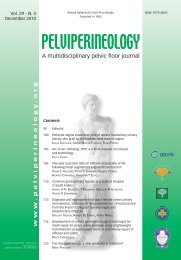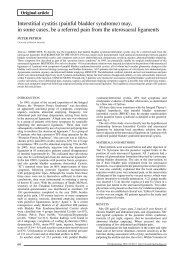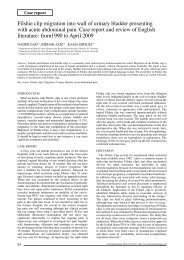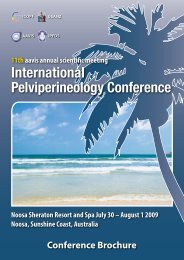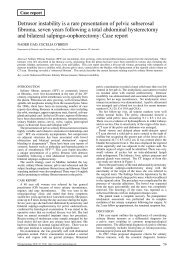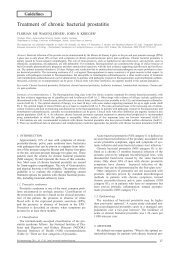Bilateral iliococcygeus fixation technicque for ... - Pelviperineology
Bilateral iliococcygeus fixation technicque for ... - Pelviperineology
Bilateral iliococcygeus fixation technicque for ... - Pelviperineology
Create successful ePaper yourself
Turn your PDF publications into a flip-book with our unique Google optimized e-Paper software.
Original article<br />
<strong>Bilateral</strong> <strong>iliococcygeus</strong> <strong>fixation</strong> <strong>technicque</strong> <strong>for</strong> enterocele<br />
and vaginal vault prolapse repair<br />
HAIM KRISSI 1,2* , STUART L STANTON 1**<br />
1<br />
Pelvic Reconstruction & Urogynaecology Unit, Department of Obstetrics and Gynecology, St. George’s Hospital, London, UK.<br />
2<br />
Department of Obstetrics and Gynecology, Beilinson Hospital, Petah-Tiqva, and Sackler Faculty Of Medicine, Tel-Aviv University, Israel.<br />
*<br />
Clinical and Research Fellow in Pelvic Reconstruction and Urogynaecology<br />
**<br />
Professor of Pelvic Reconstruction and Urogynaecology<br />
Abstract: <br />
<br />
<br />
examination following the standardized International Continence Society scoring <strong>for</strong> prolapse, preoperative urodynamic studies, analysis of<br />
<br />
of the procedure, intra- and postoperative complications, short-term postoperative prolapse-associated symptoms and pelvic organ prolapse<br />
<br />
<br />
<br />
<br />
<br />
<br />
<br />
<br />
Key words:<br />
INTRODUCTION<br />
The exact incidence of post-hysterectomy vaginal vault<br />
prolapse is unknown, with rates ranging from 0.2% to 43%. 1<br />
Many abdominal, vaginal and laparoscopic techniques<br />
have been described to correct this condition. 2 The vaginal<br />
approach has a swifter and less painful recovery. The most<br />
<br />
<br />
<br />
3<br />
The aim of this study was to describe our experience with<br />
<br />
METHODS AND PATIENTS<br />
consecutive women<br />
<br />
symptomatic vaginal vault prolapse or enterocele.<br />
Preoperative evaluation<br />
Preoperatively, all patients underwent a standardized<br />
comprehensive urogynecologic review and complete<br />
<br />
<br />
manoeuvre. The prolapse was graded using the standardized<br />
<br />
pelvic organ prolapse. 7 <br />
<br />
pelvic support. All patients underwent preoperative multichannel<br />
urodynamic evaluation with prolapse reduction<br />
to identify occult urinary stress incontinence or voiding<br />
<br />
incontinence, additional surgery was per<strong>for</strong>med as needed.<br />
All patients were fully in<strong>for</strong>med and consented be<strong>for</strong>ehand.<br />
All data were documented and registered on electronic<br />
datasheet.<br />
Operative technique<br />
All patients received preoperative prophylactic antibiotics<br />
<br />
29: 11-14 http://www.pelviperineology.org<br />
of fractionated heparin <strong>for</strong> deep vein thrombosis prophylaxis.<br />
Surgery was per<strong>for</strong>med under general anesthesia with the<br />
patients in the dorsal lithotomy position. All patients were<br />
catheterised be<strong>for</strong>e the operation. In patients with uterine<br />
prolapse, a routine three-pedicle vaginal hysterectomy<br />
<br />
<br />
hysterectomy, the posterior vaginal wall was opened via a<br />
midline longitudinal incision, and the recto-vaginal fascia<br />
was freed from the vagina by sharp dissection which was<br />
continued to the pelvic sidewall, where the ischial spine<br />
served as the landmark <strong>for</strong> identifying the <strong>iliococcygeus</strong><br />
<br />
<br />
Using a regular needle holder with no. 0 polydioxanone<br />
<br />
-<br />
<br />
<br />
11
H. Krissi - S.L. Stanton<br />
fascia, about 1 cm medial and caudal to the ischial spine.<br />
Once the suture was secured, it was placed through the full<br />
thickness of the vaginal mucosa at the vault to anchor that<br />
side, later tied. This procedure was repeated on the other<br />
side. If a posterior or anterior repair was required it was then<br />
per<strong>for</strong>med. After closure of the posterior vaginal wall, the<br />
<strong>iliococcygeus</strong> sutures were tied on either side to elevate the<br />
<br />
<br />
<br />
<br />
rein<strong>for</strong>ce the endo-pelvic fascia. All patients were advised to<br />
<br />
Postoperative follow-up<br />
Patients were re-evaluated with a comprehensive<br />
<br />
examination. Outcome measures included the feasibility<br />
of the procedure, intraoperative and postoperative<br />
complications, prolapse-associated symptoms and pelvic<br />
<br />
Statistical analysis<br />
A computerized database was created and all clinical<br />
data were collected prospectively and evaluated at the end<br />
<br />
<br />
Statistical analysis was per<strong>for</strong>med on the paired observation<br />
<strong>for</strong> each woman, be<strong>for</strong>e and after the operation. In addition,<br />
<strong>for</strong> a given symptom or <br />
women who improved was calculated. Improvement was<br />
<br />
<br />
signed rank test was used to compare pre- and postoperative<br />
<br />
<br />
RESULTS<br />
Three other patients were lost to follow-up. The mean<br />
<br />
12.4<br />
<br />
3.7 kg/m 2 <br />
<br />
<br />
Table 1 - Preoperative and postoperative symptoms.<br />
Symptoms<br />
Preop.<br />
(n=32)<br />
%<br />
Postop.<br />
(n=29)<br />
% P value a<br />
Vaginal bulge 32 100 17.2 0.0001<br />
Stress incontinence 1 b 3.4 NS<br />
Voiding difficulty 0 0 <br />
Urgency, frequency<br />
and/or nocturia<br />
Incomplete bowel<br />
emptying<br />
17.2 NS<br />
7 21.7 2 <br />
Constipation 7 21.7 4 13.7 NS<br />
Decreased sexual<br />
activity c 3 0.02<br />
Dyspareunia 2 14.2 2 d NS<br />
a<br />
<br />
b<br />
<br />
c<br />
<br />
post operatively.<br />
d<br />
One patient had dyspareunia preoperatively.<br />
<br />
<br />
<br />
<br />
<br />
<br />
<br />
overactivity in 3, mixed incontinence in 1, and voiding<br />
<br />
a vaginal bulge. Postoperatively there was a decrease in<br />
<br />
<br />
<br />
<br />
<br />
<br />
per surgical procedure was 224 <br />
<br />
<br />
Postoperatively, one patient had left leg pain that completely<br />
<br />
positioning during surgery. One patient had uncomplicated<br />
cystitis, 1 needed a blood transfusion <strong>for</strong> symptomatic<br />
<br />
Table 4 summarizes the operative data. Preoperatively, all<br />
<br />
<br />
<br />
grade 1, but 2 of them were symptomatic. However, on<br />
<br />
Table 2 - Preoperative and postoperative vaginal examination<br />
findings.<br />
Site of prolapse<br />
Cystocele/<br />
cystouretherocele<br />
Preop. (n=32)<br />
Grade of prolapse<br />
Postop. (n=29)<br />
Grade of prolapse<br />
0 1 2 3 4 0 1 2 3 4<br />
P value*<br />
0 2 0 0 <br />
Rectocele 0 11 0 4 4 2 0 <br />
Enterocele 0 12 13 4 0 22 2 0 0 <br />
Uterus/<br />
Vaginal vault<br />
0 14 12 0 0 21 2 1 0 <br />
Other vaginal parameters Mean±SD (range)<br />
Total vaginal<br />
<br />
<br />
Vaginal introitus<br />
<br />
NS<br />
Perineal body<br />
<br />
NS<br />
<br />
NS=not significant<br />
Table 3 - Concomitant surgery.<br />
Procedure *<br />
Vaginal hysterectomy<br />
<strong>Bilateral</strong> salpingo-oophorectomy<br />
Anterior repair<br />
No. of patients<br />
(n=32)<br />
Posterior repair+perineorrhaphy 22<br />
TVT**<br />
Mesh interposition<br />
<br />
** Tension-free vaginal tape<br />
<br />
<br />
<br />
<br />
<br />
12
<strong>Bilateral</strong> ileococcygeus <strong>fixation</strong><br />
Table 4 - Surgery data.<br />
<br />
Variables<br />
Estimated blood<br />
<br />
Intraoperative<br />
complication<br />
Postoperative<br />
complication<br />
<br />
All patients<br />
<br />
None<br />
No. patients/mean±SD<br />
Blood transfusion <strong>for</strong> symptomatic<br />
anemia - 1 patient<br />
Left leg pain * - 1 patient<br />
Low urinary tract infection - 1 patient<br />
<br />
<br />
*<br />
Resolved after 3 months<br />
**<br />
One patient after TVT, all resolved in less than 2 months<br />
Table 5 - Analysis of patients with postoperative prolapse greater<br />
than grade 1.<br />
No.<br />
pts.<br />
Postop. site<br />
and grade of<br />
prolapse<br />
Preop. site<br />
and grade of<br />
prolapse<br />
Use<br />
of<br />
Mesh<br />
Previous<br />
prolapse<br />
surgery<br />
1 R2 Yes R2 Yes Yes Yes<br />
2 R3 No R1 No No No<br />
3 R3,E2,VP3 Yes R2,E2,VP1 No No No<br />
4 R2,E2,VP2 Yes R3,E2 Yes No No<br />
E2,VP2 No E2 Yes No Yes<br />
R2 N0 R2 No No No<br />
7 R2 Yes R2 Yes Yes Yes<br />
CU2 Yes CU0 No No No<br />
CU2 No CU1 No No No<br />
CU= cystoureterocele, R= rectocele,<br />
E= enterocele, VP= vault prolapse<br />
Table 6 - Comparison between patients with poor and successful<br />
surgical results.<br />
Variable<br />
<br />
<br />
<br />
Successful group<br />
(n=20)<br />
Failed group<br />
(N=9)<br />
P value*<br />
NS<br />
<br />
<br />
<br />
<br />
NS<br />
NS<br />
<br />
largest child<br />
<br />
<br />
<br />
<br />
<br />
NS<br />
2 NS<br />
Previous<br />
hysterectomy<br />
Previous prolapse<br />
surgery<br />
NS<br />
NS<br />
Symptoms<br />
Operation<br />
<strong>for</strong> this<br />
compartment<br />
cement<br />
therapy, hospitalization time, estimated blood loss during<br />
surgery and intra- and postoperative complications.<br />
* Chi-square test<br />
** BMI- body mass index<br />
<br />
3 of them were symptomatic. The mean time to recurrent<br />
<br />
Analysis of patients with postoperative prolapse greater<br />
<br />
<br />
<br />
1.0 cm<br />
<br />
difference in vaginal hiatus width or perineal body lengths.<br />
<br />
She was not sexually active and had had a previous vaginal<br />
hysterectomy combined with cystocele and rectocele repair.<br />
DISCUSSION<br />
Surgery <strong>for</strong> vaginal vault prolapse has several goals:<br />
restore the normal anatomy, relieve symptoms, restore<br />
normal bowel and bladder function, and preserve satisfactory<br />
sexual function. Vaginal vault prolapse and enterocele may<br />
be a source of frustration to the surgeon because of the<br />
<br />
term, especially when preservation of a functional vaginal<br />
length is necessary. Benson et al noted that 33% of patients<br />
who had previous vaginal surgery <strong>for</strong> prolapse required reoperation<br />
<strong>for</strong> recurrence. A variety of abdominal and vaginal<br />
surgical techniques have been suggested to correct the pelvic<br />
<br />
<br />
pelvic surgery, the quality of the pelvic support tissues and<br />
<br />
approaches <strong>for</strong> vault prolapse repair are sacrospinous<br />
<br />
<br />
include damage to the neurovascular bundle that runs in<br />
<br />
in vaginal deviation laterally and exposes the anterior<br />
vaginal wall to persistent or subsequent cystocele in up to<br />
37% of the patients. The main problematic complication<br />
of uterosacral suspension is ureteral obstruction reported<br />
in up to 11% of the patients . Other disadvantages of<br />
both procedures are the need <strong>for</strong> a certain vaginal length<br />
and mobility in order to bring the vaginal vault to the<br />
sacrospinous or uterosacral ligaments without tension, and<br />
the need <strong>for</strong> a wide dissection to visualize the sacrospinous<br />
ligaments. Such dissection may increase the risk of bleeding<br />
By contrast, the <strong>iliococcygeus</strong><br />
fascia does not have critical structures such as the pudendal<br />
<br />
There<strong>for</strong>e, it is theoretically associated with a lowers rate of<br />
pelvic pain from nerve entrapment, bleeding, and ureteral<br />
<br />
<strong>iliococcygeus</strong> fascia in relation to the other anchoring pelvic<br />
<br />
<br />
<br />
anatomic position of the upper vagina. Another advantage<br />
<br />
mobility or a short vagina that cannot be attached to the<br />
sacrospinous or the uterosacral ligaments without tension.<br />
<br />
previous surgery <strong>for</strong> prolapse. Yet, in none of them did we<br />
<br />
fascia or accomplished the sutures placement. Patients<br />
weight, vaginal length, and previous pelvic surgery had<br />
no effect on the feasibility of the procedure. There were<br />
no intraoperative complications and the postoperative<br />
complications were left leg pain in one patient, which we<br />
attributed to surgical positioning resolved spontaneously<br />
13
H. Krissi - S.L. Stanton<br />
<br />
patient needed a blood transfusion <strong>for</strong> preoperative anemia<br />
that become symptomatic postoperatively. Shull et al 10 and<br />
Meeks et al 11 <br />
<br />
et al 12 <br />
<br />
<br />
<br />
<br />
<br />
<br />
<br />
rectocele grade 2, 1 rectocele grade 1, and 2 cystouretrocele<br />
<br />
intraoperative re-assessment precluded surgery <strong>for</strong> these<br />
sites. Two other patients had deterioration of an existing<br />
prolapse, and only one patient had a denovo prolapse. The<br />
patient characteristics of the failed group were similar to<br />
those of the successfull group.<br />
<br />
<br />
in patients with multiple-site prolapse who had rectocele<br />
or cystocele grade 1 or less.<br />
<br />
with previous surgery <strong>for</strong> prolapse.<br />
<br />
Non-absorbable sutures or polydioxanone suture may be<br />
a better choice.<br />
<br />
<br />
spines inferior to the normal position of the vaginal apex.<br />
This may result in shortening of the vagina, as shown in our<br />
<br />
<br />
in order to decrease the risk of recurrence. However, in a<br />
potentially sexually active woman, attention should be<br />
directed leaving a functional vaginal length.<br />
CONCLUSIONS<br />
<br />
effective vaginal surgery <strong>for</strong> the treatment of vaginal vault<br />
prolapse and enterocele. Ef<strong>for</strong>ts should be made to correct<br />
all additional site of prolapse and to maintain an adequate<br />
vaginal length in sexually active women. The grade of<br />
prolapse should not be altered during surgery. In cases of<br />
secondary repair, a mesh interposition should be considered.<br />
Long-term follow-up is needed <strong>for</strong> further evaluation of this<br />
technique.<br />
<br />
<br />
<br />
2. Sze EH, Karram MM, Transvaginal repair of vault prolapse: a<br />
<br />
-<br />
<br />
4. Bump RC, Mattiasson A, B0 K, Brubaker LP, DeLancey JOL,<br />
Klarskov P, Shull BL, Smith ARB. The standardization of terminology<br />
of female pelvic organ prolapse and pelvic floor dys-<br />
<br />
nal<br />
reconstructive surgery <strong>for</strong> the treatment of pelvic support<br />
defects: a prospective randomized study with long term out-<br />
<br />
<br />
Pelvic support defects and visceral and sexual function in women<br />
treated with sacrospinous ligament suspension and pelvic recon-<br />
cussion<br />
1430-1<br />
<br />
postoperative analysis of site-specific pelvic support defects in<br />
<br />
<br />
<br />
<br />
<strong>Bilateral</strong> uterosacral ligament vaginal vault suspension with sitespecific<br />
endopelvic fascia defect repair <strong>for</strong> treatment of pelvic<br />
<br />
<br />
<br />
<br />
<br />
of the vaginal cuff to <strong>iliococcygeus</strong> fascia: An effective method<br />
<br />
<br />
of vaginal vault prolapse by suspension of the vagina to ili-<br />
<br />
<br />
<br />
<br />
40-4.<br />
Acknowledgment: The authors wish to thank Professor Martin<br />
<br />
data processing and statistical analysis.<br />
Correspondence to:<br />
Dr. HAIM KRISSI<br />
<br />
<br />
Israel<br />
<br />
<br />
E-mail: haimkrissi@hotmail.com<br />
14



